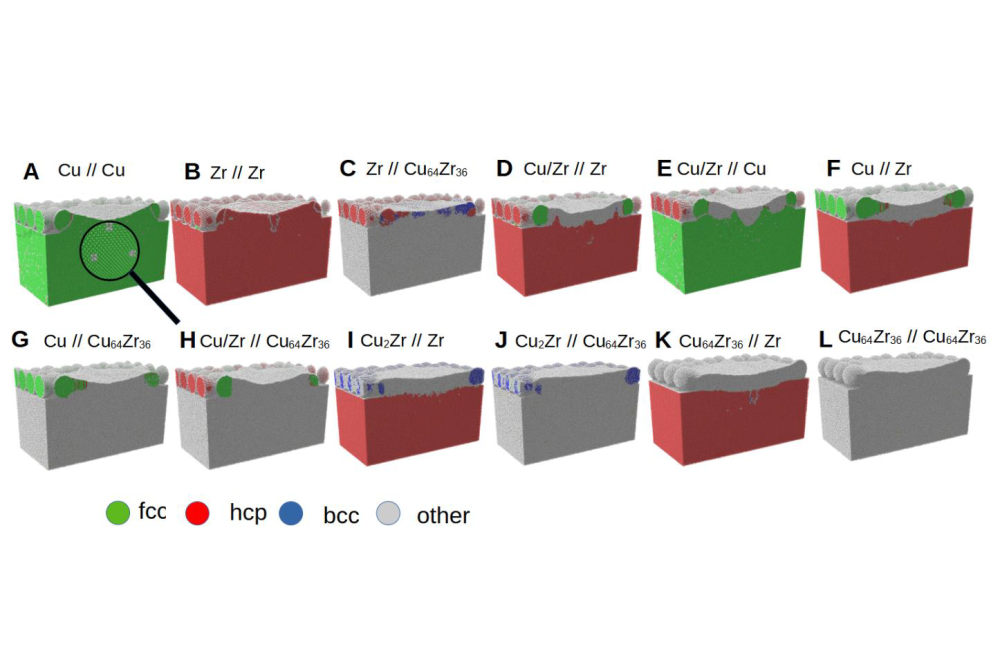Molecular Dynamics Simulation of Laser Powder Bed Fusion of Metallic Glasses
Einleitung
The fabrication of metallic glasses by laser powder melt fusion provides a new way for the synthesis of metallic glasses, but also includes a series of complicated physical and chemical phenomena occurring during the rapid melting and solidification processes. This includes the absorption and transferring of laser energy, the phase transition, and melt flow in the molten pool. Because of their complex interplay, the laser powder bed fusion process is yet to be understood in its entirety. In this work, we specifically focused on two main problems: (i) accurately predicting the thermal history during additive manufacturing, including the extremely high heating and cooling rates through phase transformation temperatures, and (ii) investigating the evolution of nonequilibrium phases. The simulation results allowed us to quantitatively reveal the reasons of the issues described above. Computer-aided prediction of the thermal history and microstructure evolution during laser powder bed fusion can be used instead of the expensive trial-and-error principle. As a model system, we used the binary metallic glass Cu64Zr36 which exhibits a high glass forming ability besides its compositional simplicity. It features a rich phase diagram and is technologically relevant due to its high strength and ductility. Additionally, their well-studied icosahedral ordering allows judging the thermodynamic stability of this glass.
Methoden
Regarding problems (i) and (ii), we used a multi-scale modelling approach to investigate how process conditions in laser powder bed fusion affect the metallic glasses formation. This gave the access to all the relevant thermodynamic and kinetic parameters, and we can explore a wide range of processing parameters. The proposed multiscale modelling addressed the following key scientific questions: alloy formation from powder blend, nano effects and the role of substrate in the laser powder bed fusion process. We employed molecular dynamics simulation to understand in more detail non-equilibrium effects in phase evolution and structure formation and the influence of powder characteristics thereupon. In particular, the effect of powder characteristics like size, morphology, packing coordination, chemical composition on effective material properties, such as thermal conductivity and specific heat, was already included within this framework. Except the initial thermal profile and the interatomic potential describing the interaction of atoms no empirical assumptions were required. As a drawback, the length and time scales that are typically accessible by molecular dynamics simulations are limited to several nanometers and microseconds. A finite difference method model can systematically extend the modelling capabilities by (i) independently studying how process parameters and powder density influence the temperature profile and the depth of melting zone, and (ii) extending the achievable length and time scales significantly. Transferring results from the finite difference method model to the molecular dynamics model and vice versa ensures reliable scale-bridging simulations.
Ergebnisse
The general approach to model the metallic glasses laser powder bed fusion (LPBF) process for predicting the beginning of crystallization has been formulated. Combining the modelling, numerical and atomic simulations is necessary for deep understanding of crystallization behaviour during laser powder bed fusion. This approach can be extended for multicomponent systems formation. The developed continuum model allows us to estimate the evolution of temperature at centre and boundary of simulation box for realistic molecular dynamics size investigation. Molecular dynamics simulations provide a way to study the delicate interplay of phase transitions, temperature gradient as well as heat and mass flow under far-from-equilibrium conditions and thus allow to relate powder properties to the resulting microstructure.
Diskussion
The lattice mismatch between the LPBF material and the underlying substrate strongly affects nucleation and growth processes. Thus, the crystallization islands typically occur under Zr for Cu/Zr powder laser powder bed fusion on Zr substrate. It is difficult to avoid the crystallization of Cu/Zr powders on hcp-Zr substrate. Crystallization can be avoided if we use Cu64Zr36 substrate for metallic glasses laser powder bed fusion. High cooling rate and the amorphous substrate are the main conditions for metallic glasses formation during laser powder bed fusion.




